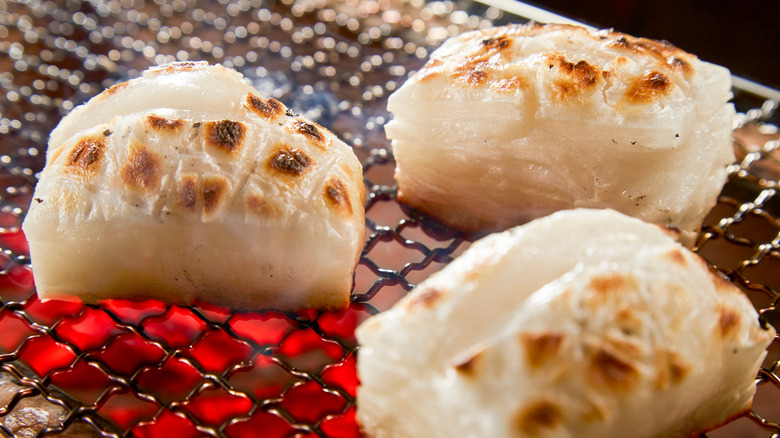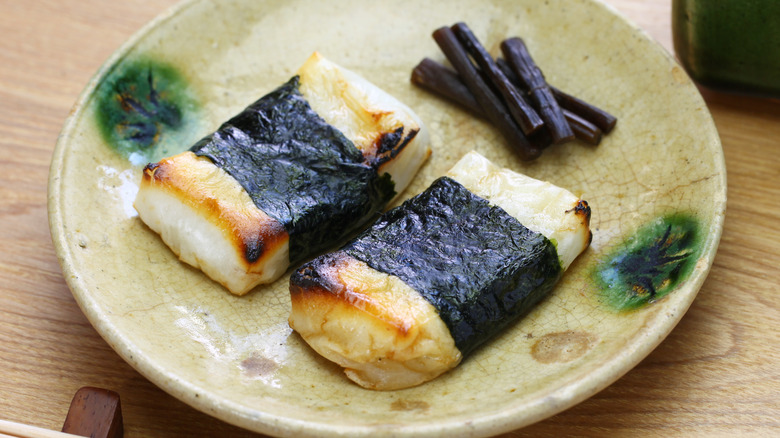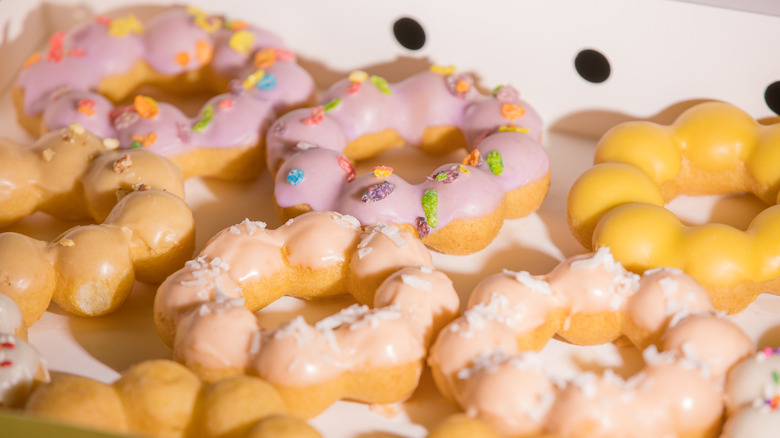Traditional Grilled Mochi Can Be Served Sweet Or Savory
Mochi is a versatile crowd favorite. Grilled, fried, doughy, or frozen and filled with ice cream, mochi is a popular go-to snack with roots in Southeast Asia and Japan. By the Heian or "peace" period (794 to 1185), mochi had become almost synonymous with Japanese New Year's traditions. Specifically, kagami mochi (identified as a two-tier tower of mochi with a bitter orange on top) is a New Year's essential and symbolizes protection. It serves as an offering to Toshigami, a Japanese god who brings good fortune on the first day of the year. However, mochi is not reserved solely for this holiday; it is enjoyed consistently throughout the year. But what exactly is it, and why has it become so popular around the world?
Mochi is a squishy, round ball of mashed glutinous rice. On the other hand, daifuku mochi is made from glutinous rice powder. It is infused with a filling of choice, such as red bean paste, and is often eaten as a sweet dessert in Japan. In the 1990s, a California family-owned and operated bakery began producing mochi ice cream. This chewy frozen treat became wildly successful in Western countries but soon grew into a worldwide obsession. Still, mochi does not have to contain a filling. It can be skewered and wrapped with seaweed, otherwise known as "norimaki." This type of mochi is either grilled or toasted and topped with a thick glaze. Thus we introduce yaki mochi or grilled rice cakes.
Grilled mochi is both a meal and a dessert
Think of yaki mochi as a family tree with these rice cakes as the roots. From there, you can make anko mochi, isobeyaki mochi, natto mochi, and many other variations stemming from the original. Small but exceedingly effective ingredients separate these from one another and can make a difference when choosing between a sweet or savory experience.
If you're in the mood for something more savory, seaweed-wrapped grilled mochi (isobeyaki) might just be your next favorite thing. All these grilled rice cakes need is soy sauce and a seaweed wrap, which will deliver those desired umami tastes. Another savory pairing is natto. Although this tends to be more controversial in taste and smell, natto is an extremely healthy blend of fermented soybeans that pairs well with grilled mochi. The salty and nutty flavors from the natto can deepen this mochi's taste while simultaneously packing on the probiotics.
One of the simplest ways to enjoy sweetened grilled mochi is by using red bean paste. Essentially, this snack is like a deconstructed daifuku, with grilled mochi on the bottom and sweet bean paste on the top. Equally sugary and tasty is kinako mochi. Here, the yaki is coated in a thin mixture of sugar and soybean flour. But, if you're looking for an overall easy mochi that is both sweet and savory, all you really need is soy sauce and sugar. These can be blended into a glaze and drizzled on yaki mochi.
Mochi can be enjoyed as doughnuts, waffles, and raindrops
Outside of its traditional form, mochi can be crafted into some pretty recognizable treats, like doughnuts and waffles. They are similar to mochi balls in that they use the same glutinous rice flour but greatly differ in their levels of chewiness. Mochi doughnuts are fluffy and crispy on the outside and are often covered in a sugary Japanese glaze. Mochi waffles provide a similar mouthfeel, though they can be topped with ice cream or fruit. In contrast, mochi balls are doughy, dense, and tough to chew (some have even died from improper digestion).
Traditional mochi can also be crafted into hybrid forms, like boba and gelatin. Instead of the usual ice cream or sweetened bean paste filling, some pillowy mochi balls contain sugar-coated tapioca pearls inside. TikTok account @worldfoodradarr shows the process of flattening the mochi before lining it with layers of cream and a scoop of those delicious black pearls.
Raindrop cake mochi is almost exactly how it sounds. The transparent mochi ball looks like one giant water droplet that can be covered in kinako and sugar syrup. Since its creation in 2014, the raindrop cake has become one of the best-selling market treats in Japan. However, there's just one catch — it's not technically mochi. Instead of using glutinous rice flour, raindrop cake mochi is made from agar-agar. This gelatin-like consistency comes from seaweed and is what makes this treat so bouncy.


